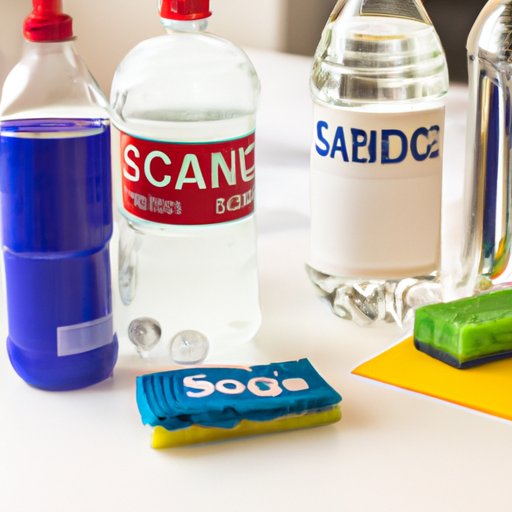
I. Introduction
Cleaning your house can be an arduous task. You may have heard about the combination of baking soda and vinegar, but do these two substances really work well together? We will explore the chemistry behind baking soda and vinegar mixing, their benefits and drawbacks, and the safety precautions you should take when cleaning with them.
II. The Chemistry Behind Mixing Baking Soda and Vinegar
Baking soda, also known as sodium bicarbonate (NaHCO3), and vinegar, which is acetic acid (CH3COOH), are both weak acids and bases. At the molecular level, the ingredients react when they are combined, producing carbon dioxide (CO2) gas, water, and another compound called sodium acetate (NaC2H3O2).
This reaction is what causes the fizzing sensation when they are mixed. The acetic acid reacts with sodium bicarbonate, which produces carbon dioxide gas. The carbon dioxide gas then reacts with the remaining sodium ions, producing sodium acetate and water.
The fizzing reaction can sometimes be used for cleaning purposes since the carbon dioxide gas can lift dirt, grime, and other particles from surfaces.
III. The Benefits and Drawbacks of Combining Baking Soda and Vinegar
Baking soda and vinegar can be effective in cleaning different parts of your house. Vinegar’s acidic properties can break down grime and dirt, while baking soda’s abrasive properties can scrub surfaces without scratching them.
Using the combination can be beneficial for cleaning surfaces like bathroom and kitchen tiles, grout, drains, tubs, and toilets. Using this combination can also help remove stains from clothing.
However, one drawback to mixing baking soda and vinegar is its potential to damage certain materials. These substances’ acidic and alkaline properties can affect surfaces such as limestone and marble, so it is important to avoid using this combination on these surfaces.
IV. Myth-busting: Separating Fact from Fiction in the Baking Soda and Vinegar Debate
One of the most common myths about mixing baking soda and vinegar is that it is an all-purpose cleaner that can be used for any cleaning task. However, while this combination can be useful for some things, it may not be effective for all cleaning tasks. It is best to know when to use these materials for good results.
Another myth is that the combination can unclog drains. While it may work to some extent, it may not be as effective as other cleaning solutions.

V. Creative Uses for Baking Soda and Vinegar
Aside from cleaning, baking soda and vinegar can be used for other household hacks. For example:
- To create a homemade air freshener with a fresh scent that can eliminate unpleasant odors.
- To polish silverware.
- To remove pet stains from carpet.
- To clean up oil spills on the driveway, among other uses.
When using this combination for each hack, safety precautions should be observed, and the mixture should be used in the right amount.
VI. Alternatives to Mixing Baking Soda and Vinegar
There are other natural cleaning solutions that can be used as alternatives to baking soda and vinegar. These include:
- Castile soap, which is useful for mild cleaning of surfaces.
- Lemon juice, which can be used as a cleaning solution for mild stains on clothing, among other uses.
- Borax, used to clean mold and mildew in various household items.
These alternative solutions can be used for specific tasks and offer unique benefits depending on their uses.
VII. Safety Precautions When Mixing Baking Soda and Vinegar
While generally safe to use, precautions should be taken when mixing baking soda and vinegar. You should observe the following safety measures:
- Do not store the mixture for long periods since it can create pressure inside the container, which may result in an explosion.
- When cleaning with the mixture, ensure adequate ventilation to prevent inhaling the gas.
- Always wear rubber gloves and goggles when handling cleaning solutions.
- Test any solution on a small, inconspicuous area before using it on a larger spot.
VIII. Predictable Outcomes: Understanding the Results of Mixing Baking Soda and Vinegar
Mixing baking soda and vinegar can produce different results depending on the cleaning task. To avoid damaging surfaces and to yield the desired results, you have to know how much vinegar and baking soda to use in combination with water.
It is also important to keep in mind that a stronger acidic solution (Vinegar) may require less quantity, while a stronger basic solution (Baking Soda) may require a higher quantity.
IX. Conclusion
We have learned that baking soda and vinegar can be a powerful combination in cleaning your house. This mixture produces carbon dioxide gas, which can lift dirt, grime, and other particles from surfaces easily. However, caution should be advised when using this combination since it can damage certain materials.
It is essential to take safety precautions to avoid harmful accidents or reactions. If baking soda and vinegar are not suitable for your cleaning task, there are alternative natural cleaning solutions that can be used. Choose the best cleaning solution depending on the surface or stain you wish to clean to avoid damaging the surface.
Keep experimenting and finding natural ways for everyday tasks, and make sure to work safely while producing an efficient and satisfying result.





